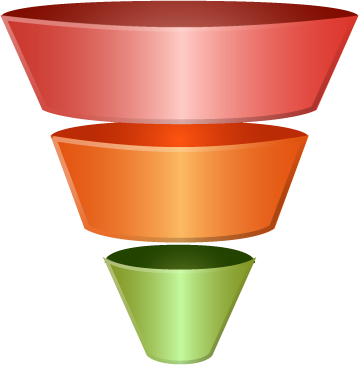What are the 3 stages of a marketing funnel?
As you know, customers follow a journey.
They don’t always buy right away.
Example:
No one wakes up and says: “I need to subscribe to a financial newsletter”.
(Even if it solves their pain).
Before we buy something, we always go through a decision cycle first.
(To make sure we’re making the right choice).
Common questions include:
- Why shouldn’t I just use an alternative?
- Why should I act now?
- Who are you?
- Why should I listen to you?
- How did you figure this out?
- How does it work?
- Why are you telling me about this?
- Is this going to be difficult?
- What do I need to get started?
- Will this take a lot of time?
- Is this risky?
- How much will this improve my life? / How big are the results? / How much $ can I make, etc.
- How fast will it take to see results?
- How much does it cost?
- What if it doesn’t work?
And a marketing funnel answers them.
However, different people are at different stages in the cycle.
This is what legendary copywriter Gene Schwartz calls: “the 5 levels of customer awareness“.
- Unaware (ice cold traffic)
- Problem Aware (cold traffic)
- Solution Aware (warm traffic)
- Product Aware (hot traffic)
- Most Aware (sizzling hot traffic)
And you want to have content + offers for every one of these segments.
The real difference between a 6, 7, or 8 figure business is whether you understand the phases of a funnel and can successfully monetize the different points along the line.
Every funnel must be carefully engineered.
The money you make in your business depends on how well you manage the experience of every person who comes in contact with you – no matter how long they stay.
Here’s the breakdown.
Top of Funnel:
The top of your funnel should go wide with sharable + snack-able content.
This is the first point of contact for your biz.
At this point, people are either unaware or problem aware.
Some are searching for solutions to their pain points, while others are being drawn in with curiosity.
So how do you interact with them?
You create assets to attract these leads and increase AWARENESS.
Headline examples include:
- “The Morning Routine Of A Millionaire”
- “How To Start An XYZ Business”
- “5 Hacks To More Productivity”
Content:
- How to
- Hacks
- Tips
- Types of
- Strategies for
- Organizing
Delivered via:
- Ads
- Blog posts
- Social media
- Infographics (IG)
Offers:
You want 80% of your content to be top of funnel.
(It’s what gets the most eyeballs + casts a wide net).
And eyeballs = $.
Middle of Funnel:
At this stage, the prospect is becoming a lead.
They have a better idea of what they’re looking for, but still aren’t 100% sure.
At this part of the funnel, you want to have digital assets that NURTURE your leads.
(Establish rapport by providing value and enjoyment).
The content is also becoming more advanced and niched down at this stage.
Headline examples include:
- “How To Get More Traffic To Your Offer”
- “The Benefits Of Using A Lead Magnet”
- “Best Software For Email Marketing”
Content:
- Best X for Y
- Pros and Cons
- Benefits of
Delivered via:
- Downloads
- Resources
Offers:
- Case studies
- Newsletter
- Webinars
- VSL
You also want to collect pixel data of prospects who have:
- viewed ads
- visited your website
- clicked on product pages
- or abandoned carts/have not purchased
and hit them with re-targeting ads.
You want 20% of your content to be mid-bottom of funnel.
Why?
It comes across as less “salesy” this way.
Bottom of Funnel:
Here’s where people are making the decision to buy.
This part of the funnel accomplishes your goals.
The purpose of this stage is to increase CONVERSIONS.
You want to have a series of assets that help you close the sale.
The headlines are even MORE specific at this point.
Content:
- Reviews
- X vs. Y
- Software
- Buyer’s guides
Delivered via:
- Trials
- Consults
- Landing pages
Offers:
- Purchase
(BONUS) After Purchase:
Here’s where you establish an ongoing relationship with your customer.
- Follow up
- Complementary offers
- Encourage referrals
Conclusion
There you have it.
Create 80% of your content for top-of-funnel.
Create 20% of your content for mid+bottom-of-funnel.
When you master these steps, you will:
- Create a better business
- Build a better relationship with your audience
- And make more money.
Want to learn more? Click the button below.
You May Also Like:
My name is Mister Infinite. I've written 300+ articles for people who want more out of life. Within this website you will find the motivation and action steps to live a better lifestyle.


Pingback: The Truth About Market Saturation - Mister Infinite